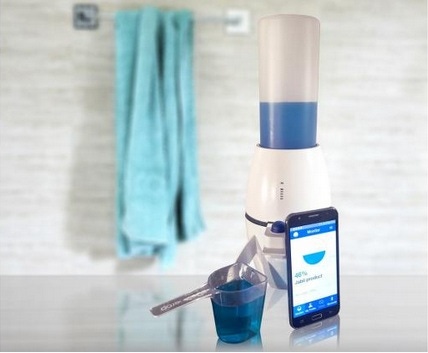Jabil’s Dash to smarter packaging for Amazon and brands
The push-button elegance of the Amazon Dash Replenishment Service (DSR) program is accelerating to the next level of instant consumer convenience for plastic packaging and more.

Picture a world of connected baby wipes. Jabil Packaging Solutions (St. Petersburg, FL) isn’t just imagining this, it’s working on this and numerous smart packaging solutions that can blow wide the enabling options to bring connected packaging to the masses for the ultra-convenience in automatic ecommerce reorders.
Things were set in motion with Amazon’s Dash Replenishment Service (DSR) program three years ago. When it was introduced in April 2015, the DSR was met with skepticism. Over time, the simple one-button solution won over consumers with simplicity and convenience and by early 2017, Dash-initiated transactions jumped to four orders per minute—quadruple the previous year’s rate.
It’s confirmed that the Dash Button’s re-order convenience has a measurable impact on product sales as well. Brands like Peet’s Coffee and Ziploc see more than 50% of their Amazon sales via the Dash Button, and Cottonelle’s share in the bath tissue category doubled from 43% to 86% among Dash users in 2016 alone.
Now DRS is moving to the next level through smart packaging and devices with embedded technology that sense when new supplies are needed, helping consumers automatically reorder product before it runs out.
As one of the first certified members of Amazon’s Solution Providers program, Jabil Packaging Solutions is “combining proven electronics, wireless communications, sensors and supply chain management capabilities with massive manufacturing scale to transform the packaging landscape” for ecommerce.
PLASTEC Minneapolis 2018 October 31-November 1 is part of the Midwest’s largest advanced design and manufacturing event that also includes MinnPack brings you the latest in materials and additives, injection molding, rapid prototyping, coatings, automation, packaging and more. For details, visit PLASTEC Minneapolis. |
PlasticsToday connected with Amanda Williams, smart packaging lead, Jabil Packaging Solutions, who answers questions about this leading-edge, smart-packaging push in convenience that's beneficial for consumers and brands.
What kind of packaging and containers can Jabil’s DRS be used with?
 Williams: The short answer is just about any kind of container. Jabil routinely develops and manufactures bespoke devices that are unique to each customer. The longer answer: We have already put work into reference designs for commonly occurring product form factors, such as liquid level sensing (e.g. for water, liquid cleaners, laundry detergent, shampoo), bulk solid level sensing (e.g. for pet food, candy), NFC-based smart racks (e.g. for spices, bottles of soap and shampoo in the bathroom), and sheet-based extraction sensing (e.g., for resealable plastic bags, baby wipes, aluminum foil). We can develop solutions outside of these, but because we've already put in some work here, customers can expect to see some speed-to-market advantages in developing those types of solutions.
Williams: The short answer is just about any kind of container. Jabil routinely develops and manufactures bespoke devices that are unique to each customer. The longer answer: We have already put work into reference designs for commonly occurring product form factors, such as liquid level sensing (e.g. for water, liquid cleaners, laundry detergent, shampoo), bulk solid level sensing (e.g. for pet food, candy), NFC-based smart racks (e.g. for spices, bottles of soap and shampoo in the bathroom), and sheet-based extraction sensing (e.g., for resealable plastic bags, baby wipes, aluminum foil). We can develop solutions outside of these, but because we've already put in some work here, customers can expect to see some speed-to-market advantages in developing those types of solutions.
What can you say about the device and form factor, is it wireless or WiFi/internet enabled?
Williams: We currently have a Bluetooth-enabled proof-of-concept, and are in the process of rolling out a WiFi-enabled one this summer. Device size is custom designed, but for the reference designs we've developed so far the electronics can be quite compact.
How and at what step is the smart device added to the packaging?
Williams: We are currently focusing on device-plus-consumable systems, which means the smart device would be something that the consumable is probably inserted into. This could take a number of forms, such as a connected baby wipe warmer, shampoo dispenser, ergonomic handle, smart spice rack, etc. Electronics in the durable device are produced conventionally. However, some of our solutions make use of a printed electronic label for the consumable; for example, to detect liquid level perfectly in consumable bottles that might come in a variety of shapes and sizes. We can currently do this with pressure-sensitive labels and can also leverage Jabil's experience with in-mold electronics.
What special features or aspects of the electronics device made it possible to integrate it with the packaging?
Williams: A "semi-smart" label, such as what I described above, connects physically with the device electronics in a way that makes the combination smart—neither element is a full sensing solution on its own. This means that a particular brand's autoreplenishment solution can be designed to work only with that brand's consumables; if the product lacks the right label, it sim ply won't be sensed. By utilizing labels printed with conductive ink, Jabil enables some electronic functionality at a cheaper price point than, say, flexible circuit boards; it's not free, but the difference in price on the consumable is on the order of choosing between a low-end label vs. a high-end label.
ply won't be sensed. By utilizing labels printed with conductive ink, Jabil enables some electronic functionality at a cheaper price point than, say, flexible circuit boards; it's not free, but the difference in price on the consumable is on the order of choosing between a low-end label vs. a high-end label.
How much development and technology were needed?
Williams: Jabil had to develop a substantial amount of software to support this system, from device firmware, to a cloud solution, to a data analytics dashboard, to a consumer-facing app. In order to properly enable automatic product reorders from a package, we have to handle user management, device management, security, data storage and potentially rapidly changing levels of user activity on the system.
Think of it this way, if you were using Facebook in 2009, your page probably loaded very slowly for a while, because they were adding users so fast the computers running their website couldn't keep up. The same thing can happen if you're supporting a bunch of devices connecting to your software... unless you deliberately architect it to be able to scale up fast. Don't get me wrong, developing the device is a lot of work, but it's just the tip of the iceberg.
What applications beyond the Amazon DRS button would be possible with the tech?
Williams: The purpose of Dash Replenishment Service is to allow solution providers to broaden the hardware options beyond just the button. You could simply embed a "reorder" button into, say, a smart bathroom shelf. Or you could embed QR codes or NFC tags into each bottle so the shelf can read what's on it; you could tap the bottle to your shelf or smartphone to reorder. Or each bottle could sense the level of liquid inside and reorder at 20% full.
We have a few reference designs that are pretty cool, but not exhaustive, and I expect we'll see a broader variety of solutions than I can even anticipate right now.
 What plastics packaging or plastic-molded products/packaging would or could this be appropriate for? And would the device be added to the container?
What plastics packaging or plastic-molded products/packaging would or could this be appropriate for? And would the device be added to the container?
Williams: This platform is meant to be pretty agnostic with regard to hardware, so as a manufacturer we are "only" limited by our manufacturing capabilities. Some good examples might be:
A coffee machine that recognizes when a coffee pod is placed inside it, and is linked to your account such that it can count uses and knows when you only have a few left.
A soap dispenser that can measure level of liquid in the consumable.
A baby wipes warmer, where you'd place the disposable package of wipes inside, and it can count the number of wipes you've pulled out.
In most cases, as illustrated above, the consumable is inserted into the device, but that's not necessarily a requirement.
At Jabil, we think that, with the increasing importance of e-commerce, we are likely to see more combo solutions… so, for example, a rigid dispenser, frame or handle that would be reusable, with a refill that might be flexible or rigid-flex in order to better withstand shock and reduce weight for shipping.
How can or may this technology change or transform the plastics packaging landscape?
Williams: We think auto-replenishment will be transformative in a couple of ways.
One is that dispensers and durable packaging will routinely include electronics to connect and enable re-orders. This adds some extra cost up front, but leads to considerably better sales of the consumable product. Looking out a couple of years, we may even start seeing connected consumables, enabled by new fabrication techniques such as roll-to-roll printing of functional electronics.
We also expect that this will only accelerate the rise of e-commerce, which means that it's going to be even more critical to design packaging well for that last-mile delivery. This means withstanding shocks and general banging about, packing well into tertiary packaging with other products, opening for the consumer without a lot of frustration, reducing the need for wasteful secondary packaging, and maybe even smaller unit sizes or concentrates to reduce weight for shipping.
What's important for plastic molders and plastic container manufacturers to know about this?
Williams: Now more than ever, the big brands need to get creative to adapt to the changing retail landscape and expectations of millennial and younger consumers for the type of relationship they're going to have with brands. This is going to impact packaging manufacturers and suggests that we all also need to get creative and be true innovation partners for our customers.
About the Author(s)
You May Also Like




